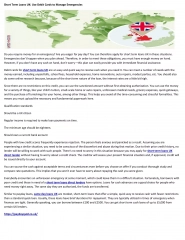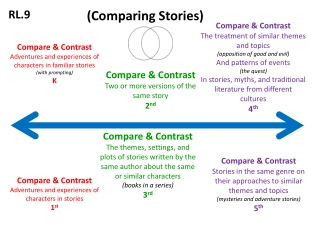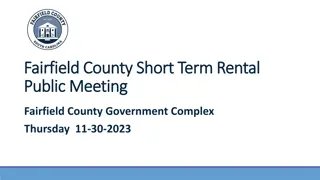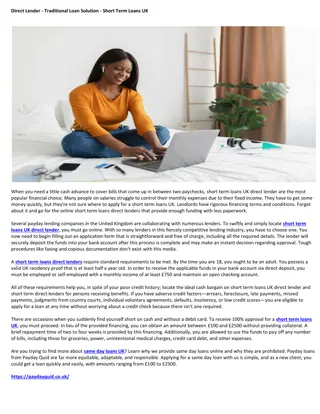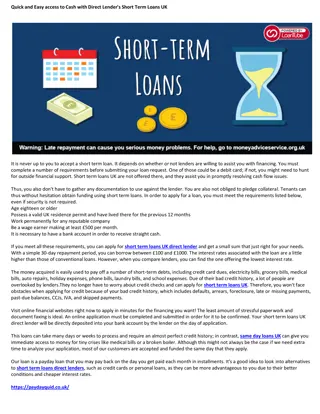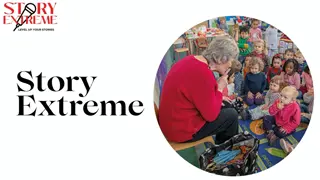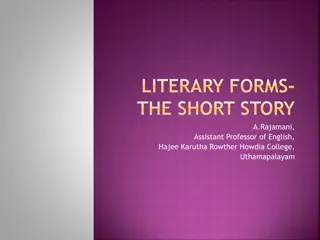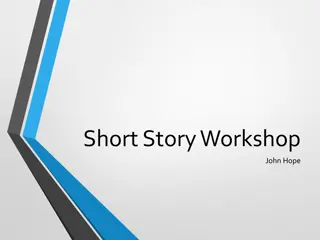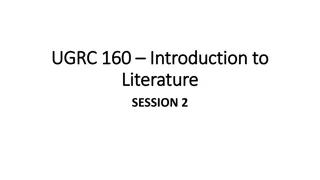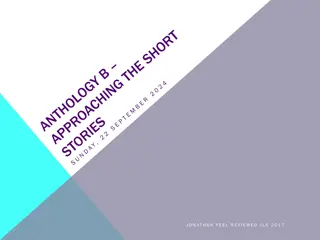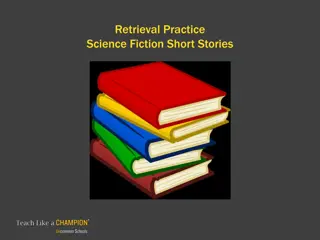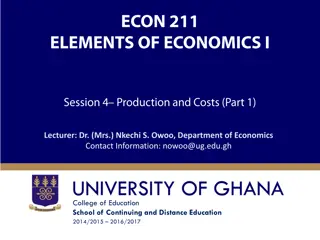The Elements of Short Stories
Exploring the key components of short stories, this guide covers plot structure, setting, conflict, and more. Learn how elements like introduction, climax, and resolution shape narrative arcs and engage readers.
Download Presentation

Please find below an Image/Link to download the presentation.
The content on the website is provided AS IS for your information and personal use only. It may not be sold, licensed, or shared on other websites without obtaining consent from the author.If you encounter any issues during the download, it is possible that the publisher has removed the file from their server.
You are allowed to download the files provided on this website for personal or commercial use, subject to the condition that they are used lawfully. All files are the property of their respective owners.
The content on the website is provided AS IS for your information and personal use only. It may not be sold, licensed, or shared on other websites without obtaining consent from the author.
E N D
Presentation Transcript
PLOT The arrangement (sequence) of events in a story that develop the author s ideas Planned logical series of events having a beginning, middle, and end There are five elements of plot: Introduction or exposition Rising action Climax Falling Action Resolution
PLOT STRUCTURE Climax Resolution Initial Event Exposition
1. INTRODUCTION Also called the exposition The beginning of the story where the characters and setting are introduced 2. RISING ACTION Events in the story become complicated Conflict in the story is revealed The events that occur between the introduction and climax
3. CLIMAX Highest point of interest The turning point The reader wonders what will happen next; will the conflict be resolved or not? Consider the climax as three parts: The main character receives new information The character accepts this information realizes this information, but does not necessarily agree with it. The character acts on this information makes a choice that will determine whether or not he/she gains his/her objective
4. FALLING ACTION The events and complications begin to resolve themselves Events between the climax and resolution 5. RESOLUTION Also known as the denouement The final outcome Untangling of events in the story
SETTING Revealed in the exposition of the story The time and location in which a story takes place Aspects of setting: Place geographical location. Where is the story taking place? Time when is the story taking place? Historical period, time of day, year, etc. Weather Conditions is it rainy? Sunny? Stormy? Etc. Social Conditions what is the daily life of the characters like? Does the story contain local colour (writing that focuses on the speech, dress, mannerisms, customs, etc. of a certain place) Mood or atmosphere the tone of the story. What feeling is created at the beginning of the story? Is it bright and cheerful, or dark and frightening?
CONFLICT The conflict is the main problem or struggle in a story Essential to plot, without a conflict there is no plot Makes the plot move forward and makes it interesting In a short story there must be one central struggle, or there may be one central struggle with many minor ones There are two types of conflict: 1. External a struggle with a force outside one s self 2. Internal a struggle with one s self
External Conflicts: 1. Person vs. Person (interpersonal) the leading character struggles with his/her strength against another person. Can also be vocal. 2. Person vs. Nature (physical) the leading character struggles with aspects of the natural world. 3. Person vs. Circumstance (classical) the leading character struggles with fate or the circumstances of life facing him/her. 4. Person vs. Society (social) the leading character struggles against ideas, practices or customs of other people. Internal Conflicts: 1. Person vs. Him/Herself (Psychological) the leading character struggles with his/her own soul, ideas of right/wrong, physical limitations, choices, etc.
CHARACTER Has two meanings: The person in a work of fiction The characteristics of a person
PERSONS IN A WORK OF FICTION: PROTAGONIST The main character Central to the story All events are of some importance to this character The character that is primarily involved in the main conflict of the story ANTAGONIST The character opposing the main character The character that brings about the conflict Generally the bad guy
CHARACTERS ARE: ROUND many sided, and complex personalities. They are not stereotypical and often surprise readers with unexpected behaviour and values. DYNAMIC a character that undergoes a change over the course of the story. The conflict and plot of the story affects a dynamic character and causes a change within him or her. FLAT stereotypical character. Usually one dimensional, static and shallow. STATIC a character that does not change throughout the story. This character is the same at the end of the story as they were in the beginning
THE CHARACTERISTICS OF A PERSON: In order for a story to seem real the characters must seem real Characterization is the information the author gives the reader about the characters We learn about a character through: 1. Their physical description 2. The character s actions 3. The character s words (dialogue) 4. The character s inner thoughts 5. What other characters say and think about the character
STYLE The technique the author uses to express him/herself and convey ideas and central purpose. Style is very personal In order to determine an author s style, one must consider the following: 1. Diction 2. Sentence Structure 3. Point of View 4. Irony 5. Symbolism 6. Imagery
1. DICTION Refers to the author s word choice: FORMAL usually found in academic text, academic papers, and formal discourse INFORMAL relaxed conversation and is found in writing that has a lighter tone and is somewhat humorous COLLOQUIAL everyday usage of a particular group. For example, in Cape Breton people say A bun of bread , A sup of pop , etc. SLANG a newly coined word not accepted for formal usage yet, and is usually not found in the dictionary
2. SENTENCE STRUCTURE The type of sentences used: SIMPLE COMPOUND COMPLEX SHORT LONG
3. POINT OF VIEW The perspective from which a story is told. The narrator tells the story. FIRST PERSON the narrator relays the story to the reader as a first-hand account. The narrator was a participant or observer in the story and is now relaying what he/she actually saw, heard or felt. Personal pronouns are used. For example, I, me, we, us, etc. The reader is limited to what the person relaying the story knows. SECOND PERSON the narrator addresses the reader as you . Often a composition that relies on the second person ends up sounding preachy and offensive.
THIRD PERSON a detached narrator tells the story in an objective manner. No personal pronouns are used. There are three variations of the third person point of view: Omniscient the narrator tells the story with complete and unrestricted knowledge. An omniscient narrator knows the internal thoughts and feelings of every character involved in the story and can move freely between geographic locations, and time. Limited the narrator filters his/her story through the perspective of one character. The narrator can still convey that character s internal thoughts and feelings, but all other characters are developed through the viewpoint of the central character. Objective the narrator has the freedom to move in space and time, but he can only relay action and dialogue, forgoing the ability to delve into characters thoughts and feelings. This is much like a movie where the audience can view what the actor does, and hear what they say, but does not know what they are thinking.
4. IRONY A contradiction between what the reader expects and what actually happens in the story VERBAL IRONY when an author or speaker says exactly the opposite of what he/she means SITUATIONAL IRONY when the reality of a situation differs or seems opposite from what is expected DRAMATIC IRONY when the reader or audience knows more about the situation than the actual characters in the work
5. SYMBOLISM A symbol is one thing that represents or stands for another. Generally an object, person, situation, or idea that deepens the meaning of the work by evoking content that is not literally expressed in the work itself Are the key to understanding a work Often an author will use images when they want to convey important ideas For example a red rose could symbolize beauty or love, but a red rose with wilted petals might symbolize faded beauty or lost love.
6. IMAGERY The goal is to make the reader actually see, feel, taste, touch, or smell the subject or idea at work There are two types: Sensuous Imagery Images the appeal to the five senses: sight, sound, taste, touch, or smell Figurative Imagery similes, metaphors, personification, assonance, etc.
THEME Central idea or meaning of a work the core message Often an idea that the author hopes to express or better understand The best short stories have something to teach to us about ourselves, our relationships, and our world The title often points to what the writer is saying and the author may use figures of speech to emphasize their theme, such as: symbolism, allusion, simile, metaphor, hyperbole, or irony Examples of theme: Love is Blind Believe in yourself Don t judge a book by it s cover People are afraid of change
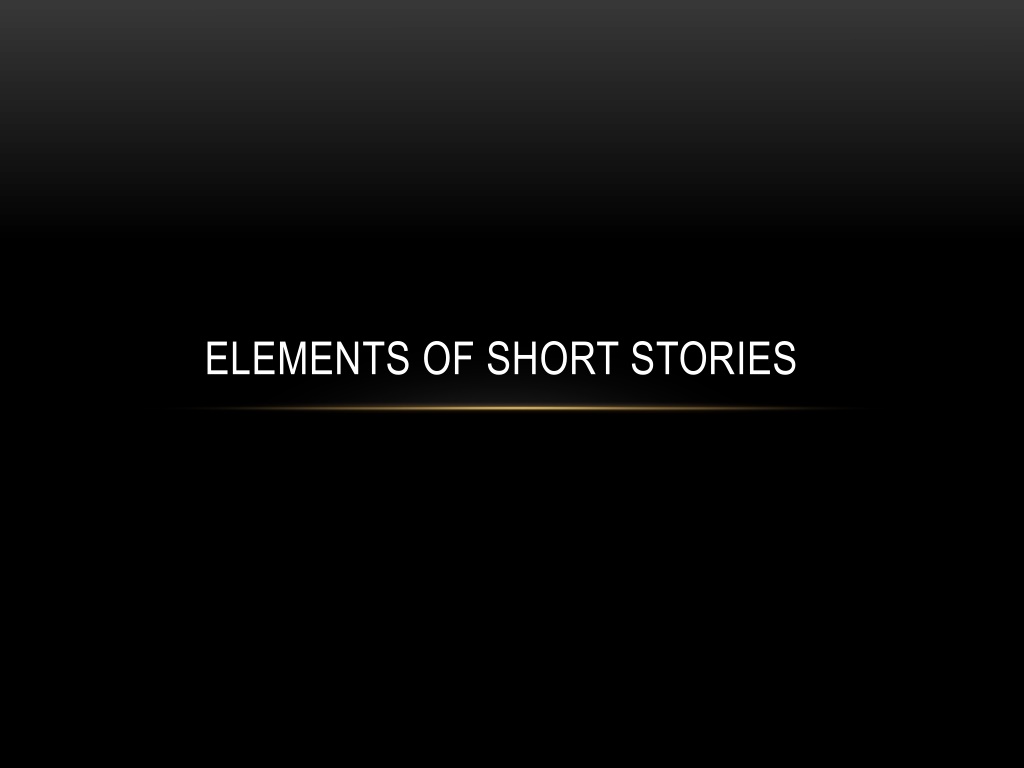
 undefined
undefined



